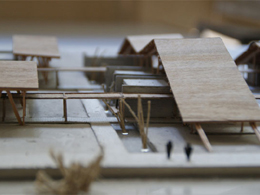STUDENTS PROJECTS
PROJECTS2013

19 May, 2014
“Weaving” in Ioannina waterfront
Professional tradition within the contemporary city.
Student: Paraskevopoulou Asimina
Instructor: Papaioannou Anastasios
Consultants: Pagonis Athanasios, Tsakanika Eleftheria
National Technical University of Athens, Faculty of Architecture
Presentation date: 18/07/2013
Short description: A design project which aims to the creation of a Center for Traditional Crafts at the waterfront of Ioannina's city lake. Workshops of basketry, chair manufacturing and woodcarving integrated to the landscape compose a contemporary market in the area.


This thesis design project aims to unpack reflections, thoughts and concerns pertaining to cities' relation with their historic past and contemporary development. The project specifically is concerned with the design of a Center for Traditional Crafts located at the waterfront of Ioannina's city lake. In a period of intense - economic, social, political - changes, on the one hand an aversion towards the urban lifestyle becomes evident, while at the extreme opposite a shift towards our birthplace cities occurs. Within the context of this trend and urge for return to primary values through eco - awareness, this thesis project focuses on redefining the relation of the urban landscape with the cultural environment, the city with the water element, human with tradition.
IOANNINA CITY
Ioannina, a city located on the banks of Lake Pamvotis, once cradle of the arts and literature, is regaining its junctional role in the present Greek landscape. The "metropolis of learning" is aiming to become a core of cultural and economic activities, not only a passage but also a stop for trade flows. Significant features and identity elements of the city are the castle, the historic center outside the castle walls and the lake.

THE WATER ELEMENT
The lakeside route especially shapes different physical scene settings and space qualities that can be identified as "vessels" hosting the lives of city residents. The city's urban area meets at a constantly changing edge with the natural environment. Focal point is the end of the Pamvotis' lakeside route on the northwestern edge of the city. The area, although located nearby the city center, is a non - urbanized field, a "dead-end" point for traffic flows. The area of intervention, characterized by a flat landscape, is in a perpetual dialogue with nature and the aquatic element.

The water element combined with the traditions and living memories of the area - there is historic evidence which reveals that the nearby Matsika settlement had been a fishing settlement - defined the center's distinct use. Traditional professions, in which reeds are used as raw material, will be housed in the center. The design of a center for traditional crafts is proposed, with workshops of basketry, chair manufacturing and woodcarving.
Cognition of tradition, learning of the craft and manufacturing of the product get intertwined, creating the necessary conditions for the existence of a space where information combined with the need for expression can be accommodated.
WEAVING SYNTHESIS
The building synthesis is formulated in such a way, that the structure and the form will unveil and conceptualize the context of the center's uses. Water, reeds, weaving are the key elements of interest and reference for craftsmen, visitors, passersby.

The weaving pattern constructs void and whole, since warp and weft threads obtain entity in the synthesis. The two elements warp and weft threads, through their knitting create space, and at the same time determine two perpendicular directions. A system emerges which is defined by the precision of a grid. Emphasis, however, is given to the intermediate space that exists between the elements, the void.
This model, although expressed in an abstract manner, provides the necessary conditions for the center's integration within the landscape. The former mentioned system becomes visually evident through the building's roofing, which emerges from the ground as folding lines, through the arcades, which illustrate public movement, and at the same time through the route's ending at the public square designed, where a tree, landmark of the area, exists.
Workshops, guesthouses, shop and library are located in ground-level spaces. A second distinct system created by stone walls encapsulates those uses. Walls are placed in different positions on the grid, designing a "sliding game" which defines indoor and outdoor spaces, private and public areas, urban and natural land.

The materials used in the design are wood and stone. Wood, a natural element, supports the building's roofing - canopies. The wooden structure, which seems to float over the ground, is visible at the façade as a folding line. The stone texture of the walls, their height being maximum 4.5 meters, gives the feeling that the spaces erect from the earth.


The linear route which is followed by the collection of raw material, the reeds of the lake, until the manufacturing of the product is evident in the heart of the center, highlighting this route not only spatially, but also cognitively. A route which progresses through time in the present with direct references to the past, always oriented towards the future.












